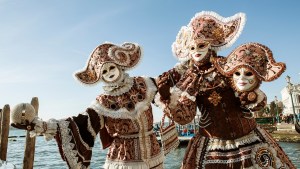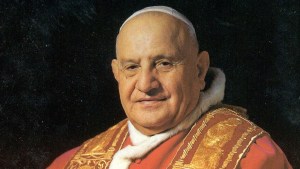On August 19, 1799, Pope Pius VI died in Valence, France, where he had been a prisoner of the French revolutionary armies. He was given a civil burial in the municipal cemetery.
The situation for the Church was disastrous: It found itself without a leader, but also without territory, since the Papal States had been dissolved in 1798. Rome was in the hands of the French, who had pillaged St. Peter’s Basilica.
A conclave in exile
Pius VI had anticipated this situation by issuing an ordinance decreeing that the conclave would be held in the city with the most cardinals. At the time, the College of Cardinals was made up of just 45 members, scattered across Europe. Finding a suitable venue for a conclave, despite Pius VI’s directives, was a tricky business.
The cardinals finally accepted the offer of the Holy Roman Emperor Francis II, who offered to finance a conclave entirely in Venice, which had been Austrian since the signing of the Treaty of Campo Formio in 1797.
The chosen venue for the conclave was the island of San Giorgio Maggiore, a small parcel of land at the entrance to the Grand Canal that had been occupied by a Benedictine monastery since the 10th century.
An intellectual, artistic, and spiritual center known throughout Europe since the Middle Ages, it houses a magnificent basilica designed by the architect Andrea Palladio.
During their passage in 1797, the French had plundered the site, taking with them Veronese’s Marriage at Cana, which can still be seen today in the Louvre. But the Benedictines remained, as evidenced to this day by the presence of two monks who now answer to Italy’s largest Benedictine monastery, Praglia.

A discreet but appropriate venue
The conclave venue is not located in the large spaces of the Palladian basilica, which is open to the public and nowadays is regularly occupied by exhibitions of contemporary sacred art organized by the Benedicti Claustra non-profit organization. To access the room now called the “conclave room,” you need to go upstairs in an adjoining building, accessible by appointment only. Before going upstairs, it’s worth making a detour to the Chapel of the Deposition, named after Tintoretto’s final masterpiece, the Deposition in the Sepulchre, which stands behind the altar. Today, it’s the daily place of prayer for the small Benedictine community.

Out of the shadows
But let’s get back to the Synod. It opened in November of 1799, with 33 cardinals in attendance, most of them Italian. The figure eventually reached 35 with the latecomers. The cardinals were seated in the coro notturno, the chapel where monks used to go to pray at night — place of silence and prayer, ideal for appointing a pope capable of leading the Church out of the shadows into which it was then plunged.

The white plastered vault contrasts with Michelangelo’s flamboyantly painted ceiling in the Sistine Chapel, but the room has its own artistic marvels. The furnishings are minimal: dark wood stalls, a matching central piece of furniture, and a high altar.

The latter immediately catches the eye, thanks to the painting above it. It’s Andrea Carpaccio’s St. George and the Dragon, depicting the 3rd-century saint piercing his adversary through with his spear. Historians believe it was probably painted for the basilica, which is dedicated not only to the painting’s protagonist, but also to St. Stephen, whose martyrdom is depicted in the background.

A political battle
Beneath this epic scene, another, more political battle was waged between the 35 participating cardinals, with the main issue at stake being how to respond to the changes brought about by the French Revolution.
Things were made all the more complicated by the fact that the camerlengo — who had the pope’s powers during the vacancy — died in the middle of the conclave. The arbiter of the debates, however, was Cardinal Consalvi. He was elected secretary of the conclave and would go on to become one of the most remarkable secretaries of state in history.
Another major player was Cardinal Franz von Herzan, who arrived late to represent the Austrian emperor. The latter, like the King of Spain — and at one time the King of France — had the exclusive right of veto during the conclave. Since the conclave was taking place in Austria, the emperor intended to install a pontiff on the Throne of Peter who was favorable to him. He had asked Herzan to pass on the message that he would refuse all cardinals from France, Spain, Genoa, or Naples.
There were two opposing candidates: Cardinal Mattei, archpriest of St. Peter’s in Rome and a hardliner against the Revolution, and Cardinal Bellisomi, bishop of Cesena (then under French rule), who seemed more amenable to negotiation. Voting continued for many days, and Bellisomi finally received enough votes to be elected, but Cardinal Herzan used the threat of an imperial veto to block his election.
The election was further complicated by the appearance of a third candidate, Cardinal Hyacinthe-Sigismond Gerdil, a Savoyard who headed the Congregation of the Index. Political maneuvering multiplied, with Spain also threatening to use its veto against Cardinal Mattei. The conclave seemed deadlocked at the end of January. February brought no change, with no new candidates emerging in Venice.
The discreet Gregorio Barnaba Chiaramonti
In March, the name of the discreet Barnaba Chiaramonti, a Benedictine bishop of Imola, was put forward. A cornered Cardinal Herzan tried to persuade Chiaramonti to accept, but wanted him to appoint a particularly conservative Secretary of State.
Chiaramonti did not want to be pope, but appeared to be the only neutral candidate for all parties, and received the direct support of Cardinal Consalvi.
On the morning of March 14, 1800, the ballot was unanimous: Gregorio Barnaba Chiaramonti was elected and took the name of Pius VII, in deference to his predecessor Pius VI. In a small staircase hidden away in a corner of the conclave hall, we find a pierced column which, it is said, was used to produce the white smoke with the ballot papers.
The memory of the election of Pius VII, a pious Benedictine and skillful pontiff, is deferentially preserved here: Cardinal Chiaramonti’s place is marked, and a plaque commemorates the event. There are several magnificent paintings of Pius VII in both the basilica and the convent.

The conclave lasted over three months, and the sede vacante period over six months. It was the last conclave outside Rome. The challenge facing Pius VII was equal to this exceptional election: a few months earlier, in November 1799, another closed-door meeting in the Château de Saint-Cloud had led to General Bonaparte’s coup d’état. He was to be the new pontiff’s great adversary.



